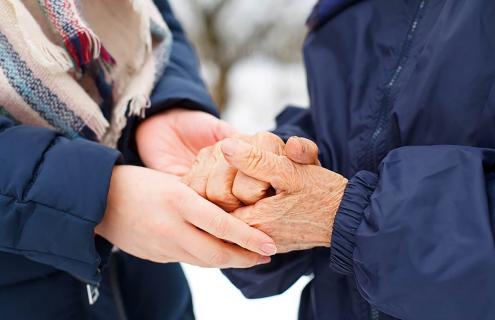
This time of year many of us are delighted to get outside and play in the snow, but without proper protection, we can expose ourselves to the risk of cold-related injuries. Weather-related power outages and car accidents can also leave people vulnerable to the cold.
It is important to take precautions against frostbite and hypothermia, even when it doesn’t feel “that cold” or the plan is to spend most of the day doing core-warming exercise because these dangerous conditions can develop without people being fully aware of them until it is too late. According to the Centers for Disease Control and Prevention, an average of 1,301 people die each year due to exposure to excessive natural cold, and many more suffer serious injury.
Check on family and friends
Children who are unaware of the risks, the elderly, and those who already have poor circulation are especially vulnerable. Help them prepare for low temperatures and be aware of signs of frostbite and hypothermia in those around you.
What is frostbite?
Frostbite is an injury caused by your tissue freezing when your body slows circulation to your extremities in an attempt to keep vital organs warm. It results in loss of feeling and color in affected areas, such as the nose, ears, cheeks, chin, fingers, or toes. Frostbite can permanently damage the body, and severe cases can lead to amputation.
Signs: Redness, tingling, and pain in the skin are the first signs (“frostnip”), whereas, the symptoms of numbness, white or grayish-yellow skin, firm or waxy skin are what is known as “frostbite.”
What to do
If it is frostbite rather than frost nip, seek medical attention immediately.
- Get to a warm room and remove constricting jewelry and wet clothing.
- If medical care is not available, soak area in warm-to-the-touch (not hot!) water or wash-cloth for 20-30 minutes.
- Use body heat to warm area, like holding fingers under your arm.
- Do NOT rub or massage area, walk on frost-bitten toes, or use a heating pad or stove because frost-bitten areas are easily damaged or burned.
What is hypothermia?
Hypothermia is an unusually low body temperature, which can happen quickly at very low temperatures or if a person is wet and becomes chilled at a cool temperature. It can also happen over an extended period of time in a cool temperature while wet or unprotected by enough clothing. This is why checking on elderly neighbors during severe cold or a winter power outage is crucial. Hypothermia can cause complications like pneumonia, heart issues and ultimately death.
Signs: Shivering, exhaustion, confusion, fumbling hands, memory loss, slurred speech, or drowsiness. The “umbles”—if someone starts mumbling, stumbling or seems bumbling, pay attention!
What to do
A body temperature below 95 degrees is a medical emergency.
- Get to a warm room and remove wet clothing.
- Warm the center of the body first—chest, neck, head, and groin.
- Keep dry and wrapped up in warm blankets, including the head and neck.
- Drink warm fluids to rehydrate.
- A person with severe hypothermia may not seem to have a pulse or be breathing. If they appear to be dead, the CDC advises bystanders to give CPR while keeping the person warm and waiting for emergency help.
Be prepared: preventing frostbite and hypothermia
- Don’t venture into very cold weather right after taking a bath or shower.
- Wear many loose layers of clothing to keep your body heat trapped inside your clothes, protect you from cold air, wind, snow, rain, and contact with cold surfaces:
- Layer 1: moisture-wicking synthetic material so your skin is never damp
- Layer 2: wool or fleece are great insulators
- Layer 3: wind and waterproof like a waterproof jacket, ski pants and waterproof boots that snow cannot get into
- Protect the parts of your body most likely to get frostbitten with a warm hat, face mask, scarf or neck warmer, mittens or gloves, wool or polypro socks, warm, waterproof boots.
- Avoid sitting or lying on cold surfaces like the ground.
- Fuel the body with enough to eat (carbohydrates for short bursts of energy and protein and fat for longer periods outside), so bring snacks. Also drink plenty of fluids. While you may not feel thirsty in cold weather, you will still lose fluids by sweating and breathing while you work or play.
- Keep a “winter accident kit” in your car, because sliding off the road (or coming across someone else who has) is a real possibility during the winter, even if you have four-wheel drive.
- Include a warm blanket, especially one lined with foil to reflect body heat.
- Stock extra clothing like socks, gloves, hat, scarf in case any of these get wet, and waterproof boots if you aren’t already wearing them.
- Buy some air-activated hand and toe warmers, snacks like granola bars, and a bottle of water (drink it before it freezes!).
- Flares in case the car slips down a bank and is not obviously visible from the road, and an extra shovel and tow rope.
